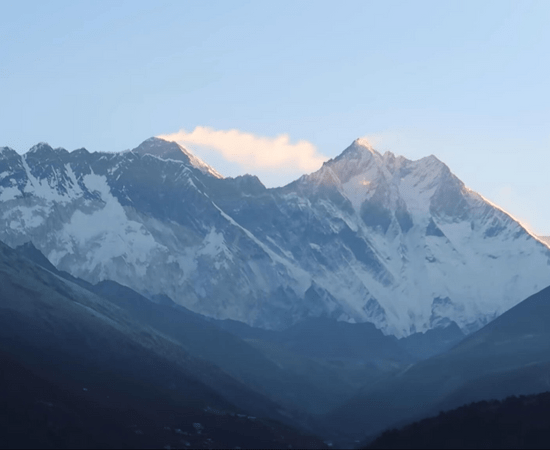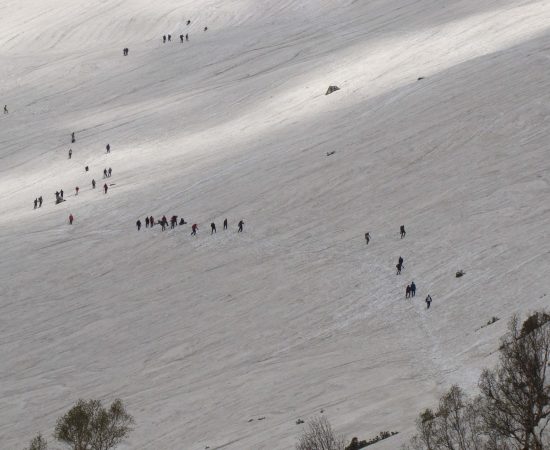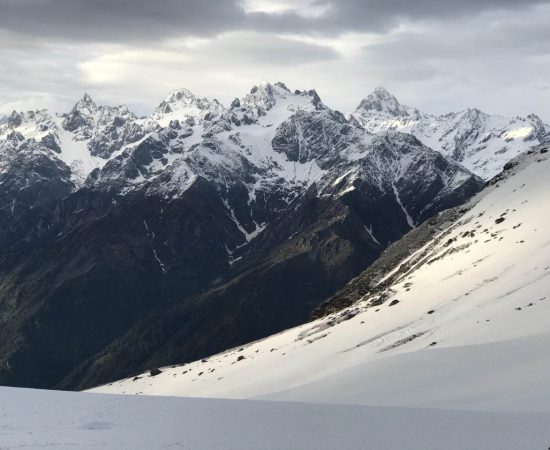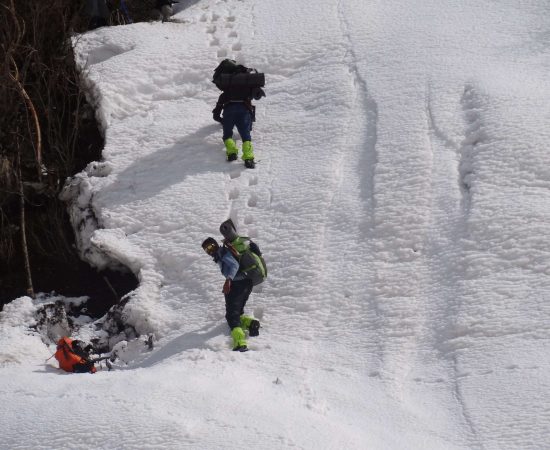Kedarkantha Trek
Sankri, Uttarakhand
Rated 4.9/5.0 on TripAdvisor. 550 Reviews


Key Highlights
- Altitude : 12,500Ft
- Time : 5 Days - 4 Nights
- Region: Sankri
- Best Time: November-April
- Distance: 20Kms
- Grade: Easy
Overview
Kedarkantha Trek
One of the locations we may refer to as a paradise on Earth is represented by the spectacular Kedarkantha mountain, which towers above Govind Wildlife Sanctuary in the Uttarkashi region of Uttrakhand at a height of 12,500 feet. According to Hindu mythology, Lord Shiva is said to have thought before going to "Kedarnath" in a place known as "Kedarkantha," which means "throat of Lord Shiva." It's a fascinating tour filled with rare plants and animals, shifting treelines, beautiful campsites, snowy mountain ranges, frozen lakes, and much more. Despite being a year-round stroll, it is particularly well-liked in the winter due to its stunning beauty and the peace of the surrounding snow. Although the mighty Himalayas are magnificent, the winter months reveal their real grandeur.
Beginning at the trekking hamlet of Sankri, the route to the joys of "Kedarkantha" is a short one. The last roadhead community at the foot of the Himalayas, Sankri, acts as a portal to the ecstatic world. Around 20 kilometres separate "Sankri" from "Kedarkanth," a journey that takes around 6 days to accomplish. The trek ends in "Sankri," which is the best part, where it started. It is growing in popularity since the walk's temperature is more pleasant than other Himalayan climbs. During the day, the temperature varies from 8 to 20 degrees Celsius, while at night, it descends to -10 degrees Celsius.
Along the way, KedarKanth provides a variety of scenic splendour, and from the top, the horizon opens out to thirteen adjacent Himalayan peaks, gilding the view even more and giving you shivers. The distance to heaven is 20 kilometres, with a gradient ranging from 6,400 feet (Sankri) to 12,500 feet. This trip is suited for beginners because to its moderate degree of difficulty. From the minute you enter the "Govind Sanctuary" via the gates until you leave, this tour never fails to enthral you. Our top priorities are improving your use of our services and making sure you have an unforgettable experience.
Cost Per Person
Key Highlights
- Altitude : 12,500Ft
- Time : 5 Days - 4 Nights
- Region: Sankri
- Best Time: November-April
- Distance: 20Kms
- Grade: Easy
Complete
Itinerary of trek
The dangerous trek to Lord Shiva's throat starts from Sankri, the last settlement to be reached by a road. Sankri is frequently considered to be a trekker's heaven since it serves as the starting point for so many other adventurous treks. Over 200 kilometres are covered in 7 to 8 hours as you travel from Dehradun to Sankri. The long journey's tiredness will disappear as soon as you arrive in Sankri, where you'll be met by towering mountains, verdant forests, and—most importantly—the welcoming smiles and rich culture of the locals. As soon as you set foot in the Village, Sankri will start to wow you.
You will go to your first destination, Juda Ka Talab, after recharging with a filling and healthy dinner. As the name implies, "Juda ka Taal" is an extraordinarily lengthy section of the mountain with a lake in the middle. When the camp is originally set up, it is the first stop on the lakeside. The lake will enthral you with its beauty and striking green, brown, and white contrasts. You will go between 3 and 5 kilometres on this day, allowing you plenty of time to be in awe of "Juda ka Taal's" magnificence.
You will be even more curious to see what the journey will offer as you continue after spending the night in a tent on the lakefront under the stars, and this trip will not let you down. You'll climb three to four kilometres on this day to reach the "Kedarkantha Base Camp," which is situated at a height of 11,500 feet. The weather will drastically shift in only 4 kilometres.
You will be reaching the peak of Kedarkantha on this day, which is a day that every trekker looks forward to. To keep you warm, breakfast and morning tea will be provided. At a height of 12,500 feet, Kedarkantha offers breathtaking views of one of the Himalaya's natural beauties. The towering hills in front of you will enthral you and steal your breath away. You will be in awe at the sense of being on a peak with the whole globe at your feet, giving you an experience of a lifetime or a tale to share with your grandkids about how you overcame the Himalayas. At the top, you will make your way down to Hargaon.
You will start to long for the thrill of this hike after you've spent the night in the tent. You will travel more than 6 kilometres downhill on this day to the town of Sankri, from whence you will resume your regular days.
Nothing lasts forever, but the excitement and adventure you had on this trip will be with you for the rest of your life. Everything you encountered will reverberate in your mind when you go back to your regular life and think back on the time you spent. It will still make you grin broadly.
Enquiry For Group Bookings
Guidelines
➽ Preparation for Trek
As you well know, the great Himalayan trek is one that requires careful preparation, a strategy that allows for enough flexibility to adapt to whatever challenges may arise.
Therefore, here are some things to consider before setting out on your trek:
⦿ Physically – You should start working out at least a month before signing up for a program if you want to be physically prepared for the rigours of a journey. Strengthen your legs by jogging and working out regularly to increase your stamina. To better acclimatise to the environment and increase your resilience on the walk, you should give up smoking and undertake breathing exercises twice a day. Engage in vigorous physical activity, such as playing sports, doing Yoga, or running.
⦿ Mentally –
Getting in shape physically is essential, but mental preparation is just as crucial for a successful walk. Take time to enjoy your regular activities, maintain a healthy diet and sleep schedule, and unwind before embarking on a hike. Predictions regarding the journey should not cause mental worry. Spend time with your closest pals to recharge your batteries and renew your spirit. Pre-trek preconceptions are unwarranted since the first contact with the other trekkers is certain to be a source of inspiration and energy. Conditions during the walk will contribute to the increase in mental readiness. The mental repercussions of physical disadvantages will not be ignored. So, when you hike, pay attention to different regions of your body and purposefully relax them. If you want to enjoy your hike, you should learn to loosen up a little, particularly in the hips. Think about your descent as a simple dance, and enjoy the natural rhythms that the path and your body can discover together gradually, whether you're on a flowing downhill route or a frightening slope. Try out a few new walking techniques to add some fun to your commute without worrying about getting somewhere in particular. Maintaining mental fitness mostly requires a willingness to relax and take in the journey, rather than subjecting oneself to undue stress.
⦿ Technically-
Get the right size hiking boots and go for it, from a technical standpoint. You should make use of 60 litres. To become acclimated to carrying heavy items, it is recommended to utilise a backpack on a regular basis. Get a hiking stick, a water bottle, some thermal socks, a fleece or feather coat, some long pants, a poncho, some flip-flops, and any devices you may need like a camera or a power bank (DSLR or digital camera).
Guidelines
➽ Things to Carry
- Good Trekking Boots: You need sturdy trekking boots with supportive high ankles. Don't bring your running shoes. U can carry extra floaters/flip flops also.
- Wear warm clothing, such three-layer coats, fleece upper, hollow fill or down-filled jackets. Carry full-sleeved T-shirt. Carry cotton hiking trek pants and warm pant for your lower body. Never bring shorts or jeans on a hike.
- Take top and bottom thermals with you.
- Quick dry towel with light weight and Personal toiletries. Suns cream lotion, sanitizer, tooth brush ad toothpaste, lip balm and antibacterial powder.
- Socks: Bring two pairs of regular socks and two pair of wool socks for wearing at night.
- A head torch is required.
- Sunglasses/ Goggle: UV-protected sunglasses are necessary to protect against sunlight and Snow Mountain.
- There should also be a woolen cap / balaclava, cap, neck gaiter cum face mask and warm fleece and waterproof summit gloves since it will be chilly. Keep waterproof gloves on hand since they become wet in the snow.
- Everyone taking part in the activity should have their own lunchbox, spoon, mug and water bottle/ hydration pack of 2 ltr.
- Raincoats/ponchos: Since snowfall and rain are frequent at high elevations, it is important to have one on hand so as to avoid getting wet.
- Trekking bag of 75 ltr with rain cover.
- Walking stik.
- Electronics: camera (optional) USB cable/USB solar charger, charger/earphones, Power bank fully charged.
- Personal first aid box. Emergency ration, energy bars, dry fruit, electoral/Ors
- Required Documents:
a) Registration Form
b) Medical Certificate (signed by a licensed MBBS physician)
c) NOC form (completed by the trekker)
d) 2 passport-size photos
e) ID Proof photo (not PAN)
g) Insurance upto 5 lac..
Guidelines
➽ How to Reach
Distance by road:-
Dehradun has excellent road connections to the rest of the country. Dehradun is linked to Nahan, 95 kilometres (km) to the north-west, and from Nahan to Panchkula, Chandigarh, and Shimla by NH72. Haridwar is the last stop on NH 72, and it's just 54 kilometres from Dehradun. From Delhi, Dehradun is 235 kilometres away. Dehra Dunk connects to Roorkee via NH58 (67 km), which leads south to Meerut (170 km) and Delhi (235 km). Delhi ISBT Kashmere Gate is where you can get a bus to Dehradun.
Location of the Closest Train Station:-
Dehradun is well-connected to other major cities in India through train, including Delhi, Mussoorie, Mumbai, Varanasi, Lucknow, and Kolkata. DDN NZM AC EXPRESS DEPARTING FROM DELHI (2205)
Closest airport:-
About 25 kilometres outside of Dehradun lies Jolly Grant Airport, the city's primary airport. From Delhi, you may take a daily flight to Dehradun.
➽ Trip Cost Includes
- Conveyance within the journey.
- Tents that can be shared.
- Advanced and knowledgeable himalayan adventure trips guide.
- Cooks, helpers, and other necessary personnel.
- Vegetarian meals (breakfast, lunch, and dinner) along the journey
- Every organisational prerequisite for a journey
- First aid kit with portal oxygen.
- Camping fees and forest permits.
- All permissions for hiking.
- All meals will be supplied while on the hike. Freshly cooked meals will include a mix of indian, chinese, and continental cuisines.
- Lodging at a hotel, guest house, home, or in tents.
- All of the group's trekking equipment (tents at base camp, use of base camp facilities)
- All trip workers, including porters and mules for everyday items (such as food, tents, and utensils)
➽ Trip cost Excludes
- Airfare or other forms of transportation costs.
- Meals and hotel accommodations.
- Personal costs include washing, cell charging, and lodge showers
- Entry permits or permission for the inner line for foreign participants.
- Personal apparel and hiking supplies, such as liners for sleeping bags and walking sticks, are required.
- Any expenditures associated with rescue efforts or an early expedition departure.
- Guides and sherpa crew are tipped.
- Personal porters to carry hikers' packs
- Personal liability insurance or emergency evacuation costs
- Personal purchases (such as bottles of mineral water, bottled or canned drinks, chocolate, dried fruit, presents, etc.).
- From and to the trailhead, food.
- 5% goods and service tax (gst).
Guidelines
➽ Special Casual Leaves
Government employee can avail the benefit of special casual leave when u join us for a trekking expedition. As per the rule of the pay commission, special casual leave can be availed for up to 30 days in a calendar years for trekking and mountaineering expeditions through a register organization. Himalayan adventure trips are a register adventure tour operator register with Indian mountaineering foundation and Himachal Pradesh tourism. Candidates have to apply for leave at least 30 days before the trek/expedition start.
Testimonials
➽ Provided By The Customers
Everything about our visit to Prashar lake was better than we could have imagined. From our initial contact with Himalayan Adventure Trips, we felt their genuine interest in learning about our group's goals and expectations, and our travels with them reinforced at every turn that they not only understood our requirements but also have the acute skill and expertise to achieve them. Having already had such a wonderful experience with this firm, I will be promoting a trek to Prashar lake to all my friends who share my passion for hiking and will specifically recommend that they work with this outfit. Absolutely fantastic; I have nothing but praise for it.
How useful was this post?
Click on a star to rate it!
Average rating 0 / 5. Vote count: 0
No votes so far! Be the first to rate this post.







